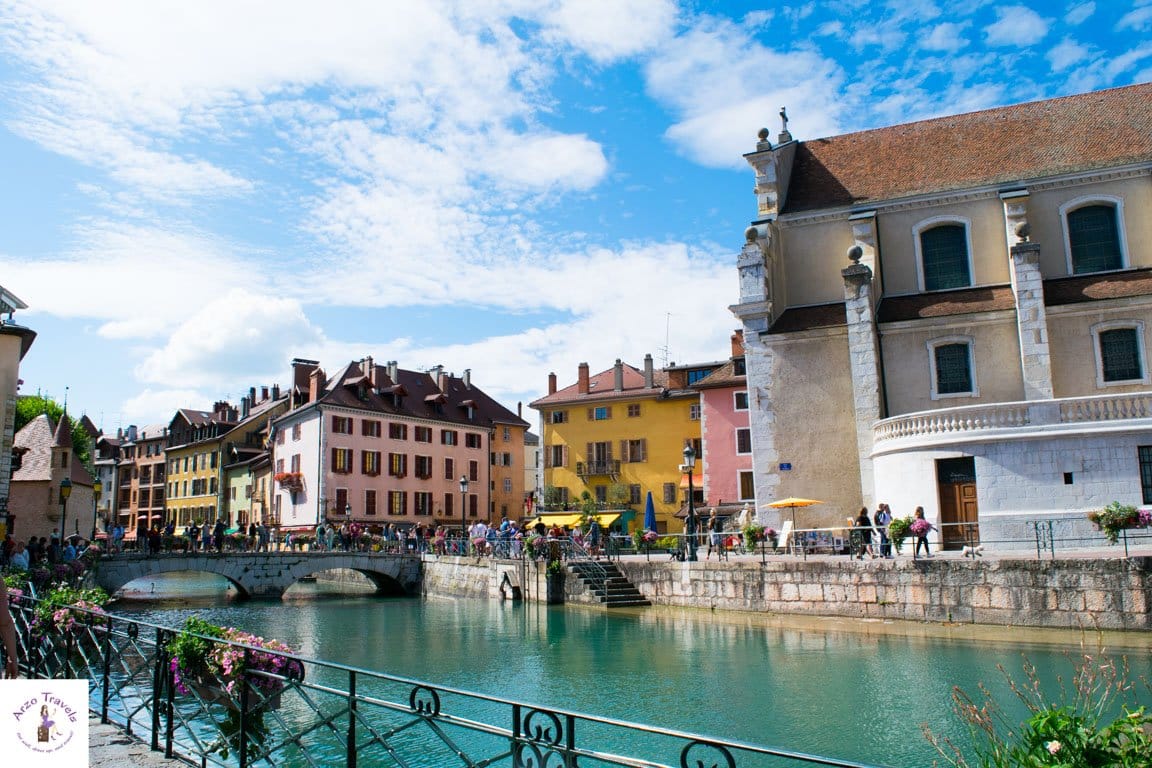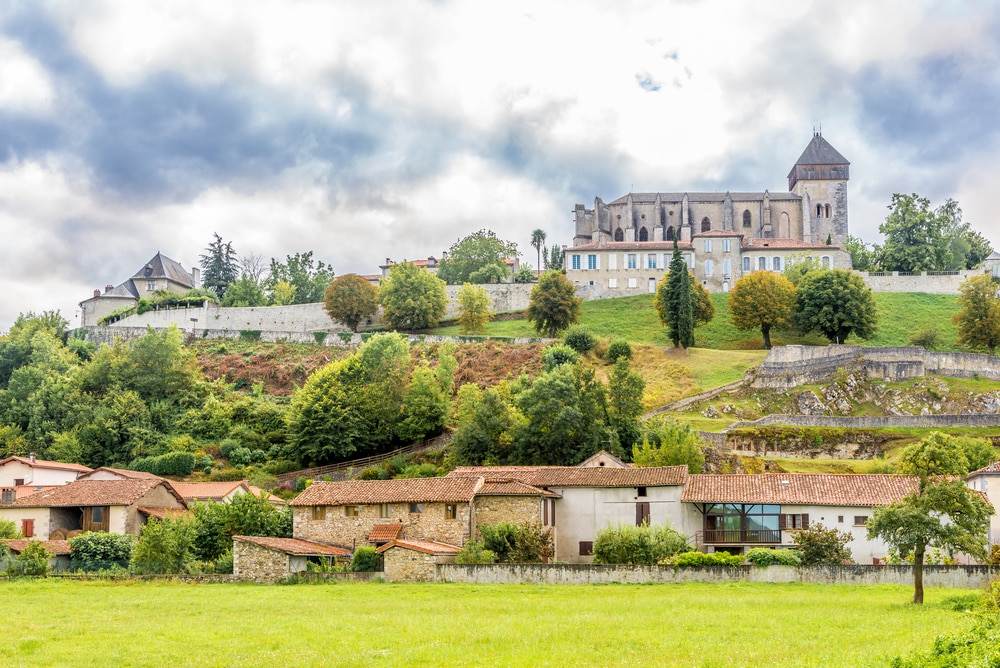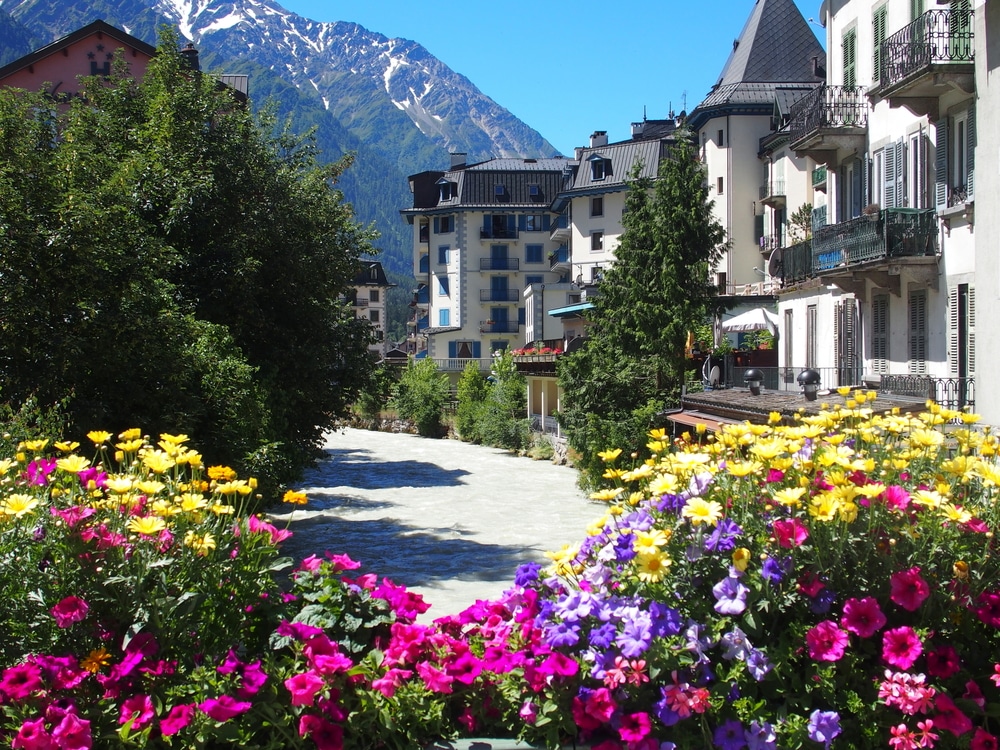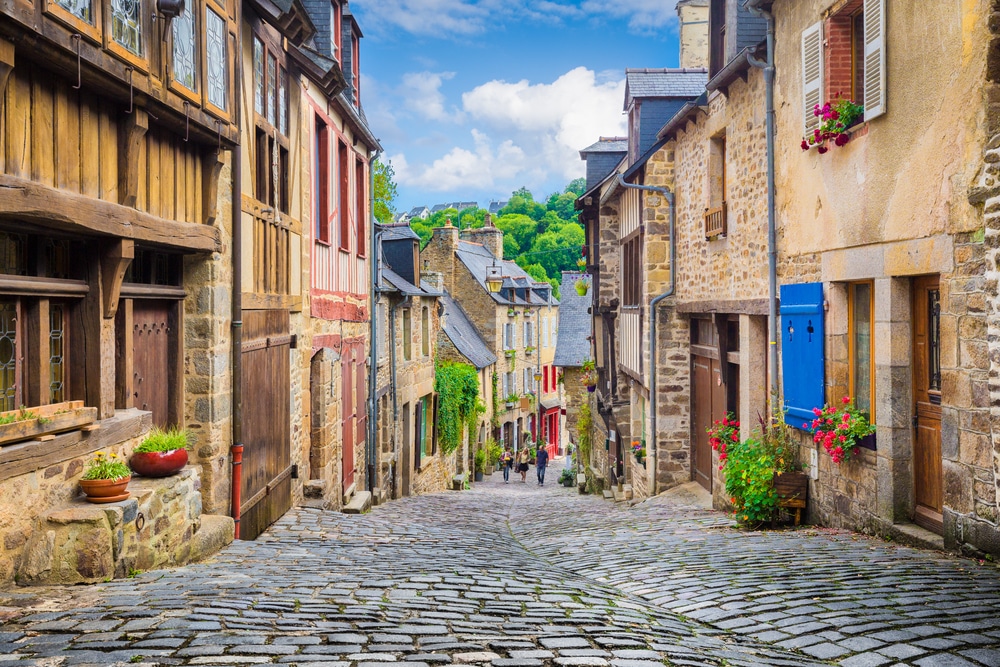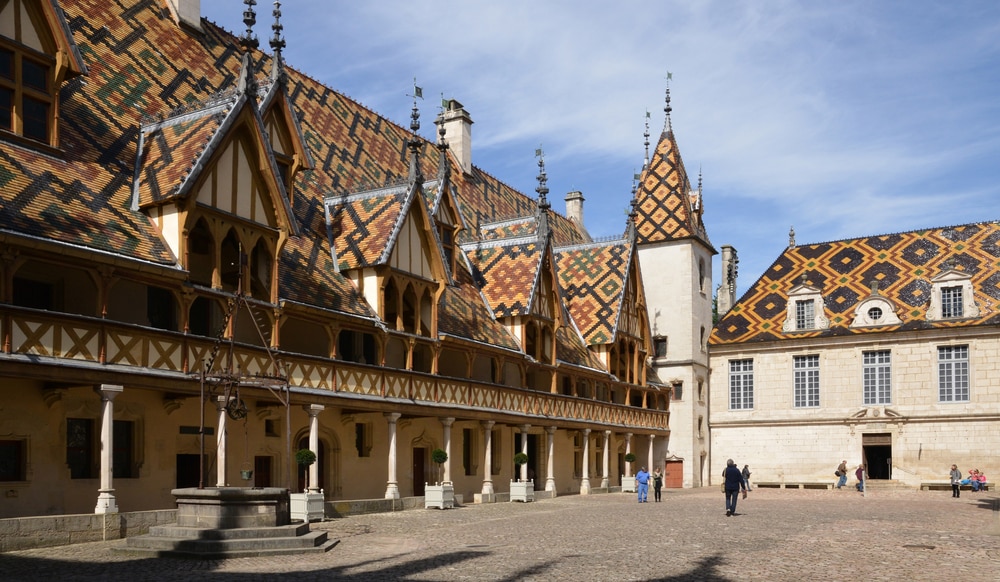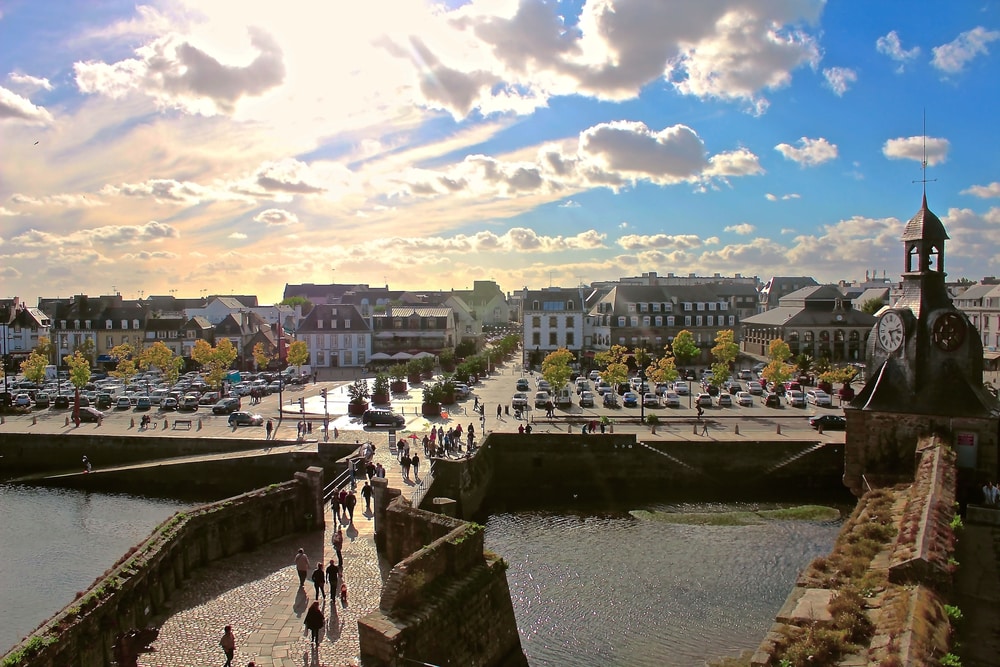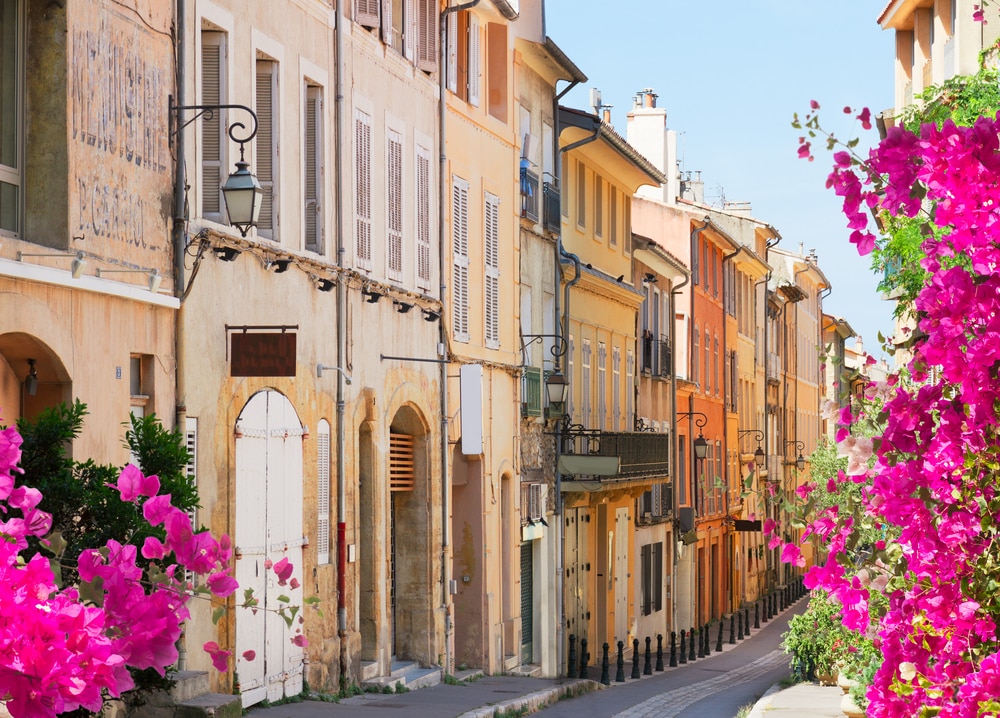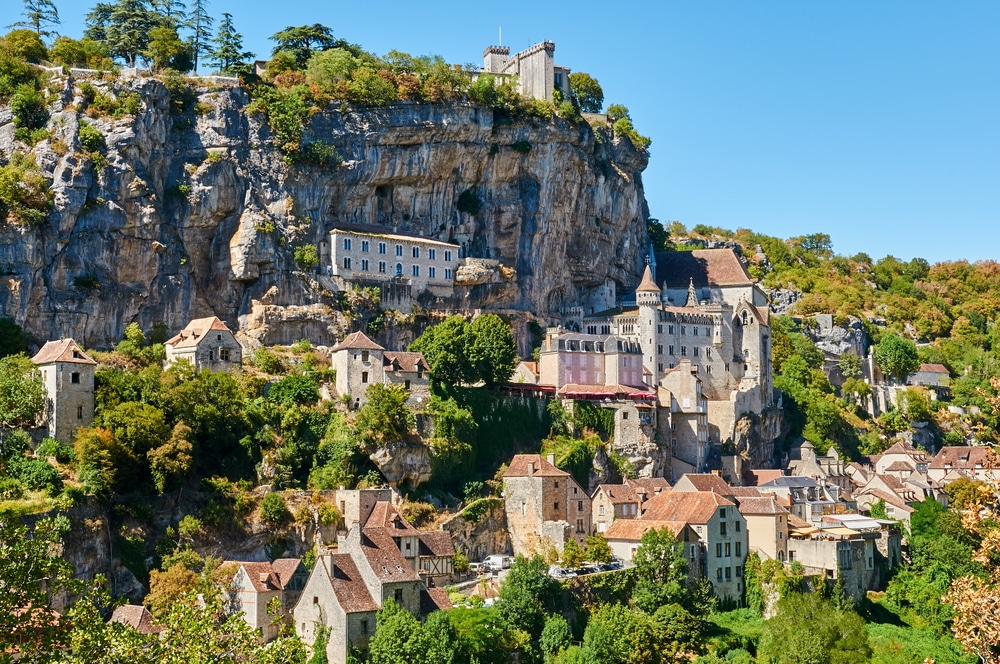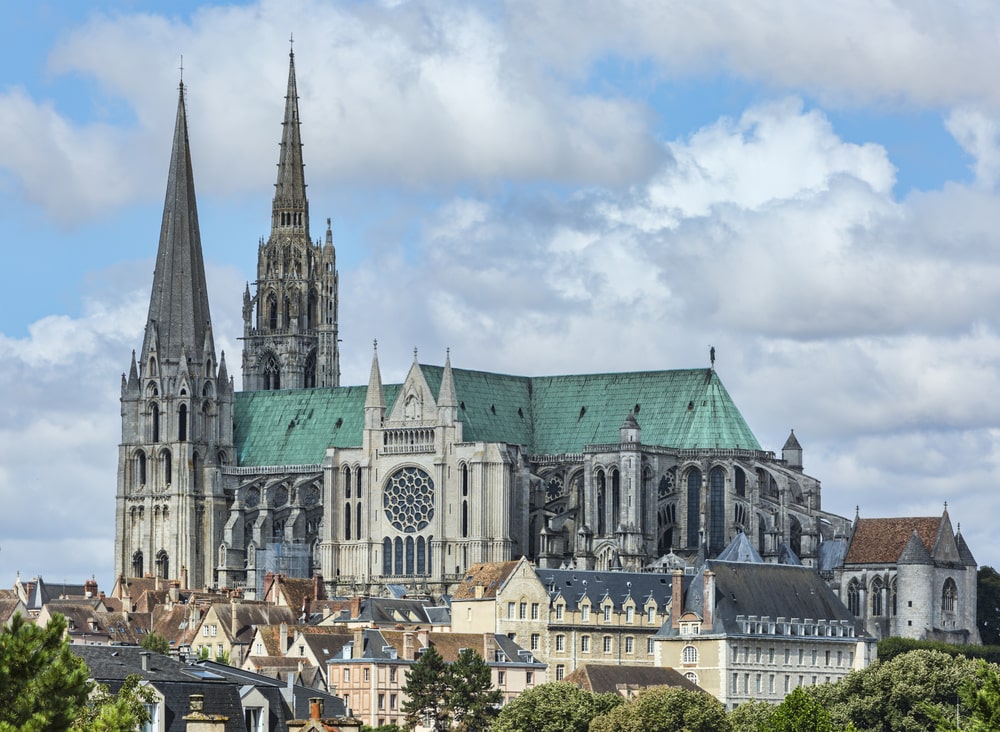BEST TOWNS TO VISIT IN FRANCE
Looking for the most beautiful towns in France? Then read on and find out about the best towns to visit.
While everyone knows Paris or about the lavender fields, there are some stunning places, some stunning towns known for France´s charm. Thus, it does not surprise that France with its cute towns is on many bucket lists.
BEST TOWNS IN FRANCE TO SEE
If you plan your France itinerary, make sure to check out these places in France – the 18 best towns in France for your next trip(s)!
Saint-Bertrand-de-Comminges
- Recommended by Rhonda Albom from Albom Adventures
The delightful village of St. Bertrand de Comminges sits on a rise at the foothills of the Pyrenees mountains overlooking the archaeological site of the Roman Ruins of Lugdunum. Both are worth a visit.
From the ruins looking up, it is the St. Bertrand de Comminges Cathedral that will call to you, urging you up the hill either on foot or in the shuttle bus. The walled city hides narrow, cobblestone roads, leading to the Romanesque Gothic cathedral, a UNESCO World Heritage Site.
Inside the cathedral is an eclectic mix of architectural styles. Renaissance stained glass windows light the 16th-century organ, while the 12th-century cloisters add an air of solitude. On an internal wall hangs a taxidermied crocodile. The cathedral is also home to the tomb of Saint Bertrand (canonized in 1671).
St. Bertrand de Comminges is listed amongst the Les Plus Beaux Villages de France (“The Most Beautiful Villages of France”).
As a side note, prehistoric cave art can be seen inside the nearby Grotte de Gargas.
Chamonix
- Recommended by Donovan from Travel Voila
Chamonix, also commonly known as Chamonix – Mont Blanc, is one of France’s oldest ski resorts. It is situated at the junction of France, Italy, and Switzerland.
During winter, every inch of Chamonix will be covered in snow. During the summer, you will still find snow at Aiguille Du Midi.
It is a “must-visit” destination for any skier or snowboarder and one of the most beautiful towns in France in winter (and summer). Apart from that, there are not many places in the world that have glaciers surrounding them, Chamonix has more than one (Bosson Glacier, the famous Mer de Glace glacier, Argentière Glacier)
However, due to global warming, the height of glaciers will decrease by 4-5 meters every year – do visit before they are completely gone.
Although Chamonix is considered a winter sports resort town, it is also very popular during the summer. You can take the cable up to 3,842 meters above sea level to Aiguille du Midi. From there, you can take a Panoramic cable car over to the Italian side – Pointe Helbronner.
That is why Chamonix is a popular holiday destination during all 4 seasons. You can have snow sports activities and hiking activities during the summer. Because of this, there are numerous chalets and Airbnbs to cater to the demand.
Top 3 places in Chamonix: are Aiguille du Midi, Mer De Glace and Pointe Helbronner.
Dinan
- Recommended by Julie and Steve from 2CheckingOut
Dinan will take you by surprise. Dinan’s medieval magic, situated high above the River Rance, full of narrow cobbled streets, transports you back in time.
The historic center knows how to switch on the French charm. Half-timbered and stone buildings beg to have their picture taken. Quaint little shops and cafes entice you to step inside.
History buffs will love exploring the ramparts and chateaus. Those strolling the ramparts are rewarded with spectacular views of the surrounding countryside.
After pottering the atmospheric center, and sampling a tasty crepe or two, you may like to explore further afield. Saint-Malo and Mont St Michel are easy day trips away.
Saint-Malo is an equally picturesque port town with a walled center. Tourists flow everywhere, but the city still maintains its charm, especially inside the walls. Mont St Michel looks dramatic from a distance, standing proud over the sand. Wandering the alleyways can be interesting if you can avoid the tacky tourist shops and overpriced restaurants.
But Dinan is where you can imagine fairytales coming true!
Annecy
- Recommended by Arzo from Arzo Travels
If I had to name the most beautiful town in France, it would be Annecy – a colorful town close to the Swiss border. Compared to most of the other towns recommended here, Annecy is bigger with a bustling old town.
Annecy is not so small to get bored easily but still has the charm of a town. Spending a few days in Annecy will allow you to see the most important places in Annecy, but even one day is good enough to explore the town.
My 2 top recommendations for Annecy are: Getting lost in the old town of Annecy, spending time around Lake Annecy, and doing a boat tour on Lake Annecy.
Lake Annecy is, supposedly, the cleanest lake in Europe, and with the Alps in the background, the scenery is stunning. While it is very tempting to only sit at the lake and soak in the sun (at least in summer), I recommend walking around the lake and enjoying a 1-hour boat tour or doing some water sports.
There is a reason why Annecy is called the Venice of France – with its colorful houses, narrow streets, and many canals, it actually reminds pretty much of Venice. Click here to read more about the best things to do in Annecy.
Beaune
- Recommended by Maegan from Wanderlust Dietitian
Beaune is a cute town situated on the Côte de Beaune, complete with its own archway and weekend markets – a visit is highly recommended to sample some food until you are stuffed.
There is plenty to do in this region during a relaxing weekend.
The top things to do here are to visit the Hospices de Beaune or Hôtel-Dieu de Beaune, which is a former charitable almshouse, get cultured at the Musée des beaux-arts de Beaune, see the Chateau de Savigny-les-Beaune, take a day trip to Dijon, enjoy the market day in Beaune, take a stroll through the many vineyards at sunset or with an organized tour, bring back some Dijon mustard (of course), and buy lots of red wine!
The Côte de Beaune area is the southern part of the Côte d’Or and is home to the best Burgundy wine ever!
Avignon
- Recommend Laura from Travel Addicts
Perched along the Rhone River, Avignon is the perfect combination of a city and a town—it has lots of attractions and things to do while being manageable and feeling completely friendly all at the same time.
Even better: Avignon is easy to reach by air or train, so it’s a no-brainer to visit on a trip to Provence.
The high-speed TGV train from Paris will deposit you right outside Avignon’s city walls in just over three hours, or it’s less than an hour by train from the Marseille airport.
Avignon’s center is compact, surrounded by walls whose origins date from the 14th century. As a result, the city is easily walkable and bustling at most hours of the day, making it feel quite comfortable for me to travel on my own.
Everywhere you go, there are locals enjoying wine in the sidewalk cafes and squares or hanging out on trendy, cobblestoned Rue des Teinturiers. Those looking for something beyond the amazing wine and food of Avignon should head to Parc Rocher des Doms, a lovely sprawling park that provides great views of the surrounding area on a clear day.
Its Marche Les Halles (the city market) is a local hangout, but it’s also great for tourists, especially if you’ve rented an apartment and are cooking (as I did).
Other must-visit spots include a distillery making pear brandy with the pears grown in the bottles and the Palace of the Popes, a UNESCO World Heritage Site that was home to seven Popes in the 1300s when controversy caused the papacy to leave Rome.
Yvoire
- Recommended by Rashmi & Chalukya from Go Beyond Bounds
France has no dearth of tourist places and neither of small pretty villages, which are great for some laid-back experience away from the crowd.
Yvoire is one of such pretty medieval villages located in southern France on the shores of Lake Geneva. Based in Geneva, Switzerland, the trip to Yvoire is easy with a travel time of less than an hour.
The Yvoire Castle and the village’s stone houses rise high above the boats and yachts lining the village shore. Yvoire is packed with well-preserved stone houses, which are sure to transport you into the bygone era with its old-world charm.
The windows and balconies of these houses adorned with bright, colorful flowers are a delightful sight to behold. And while you are there, do not miss a visit to the 11th-century church of St Pancras, the Garden of the Five Senses, and indulge in several scoops of yummy gelatos.
Concarneau
- Recommended by Marie-Carmen from Orient Excess
Along the coast of Brittany, in Finistere (literally translated as the end of the earth) in the West of France is the little town of Concarneau.
A fishing port still in use sees quite a few visitors come spring and summer for the many festivals happening locally and for the old town and its ancient walls, still intact to this day.
Try to visit in the morning, and you’ll find many old shops selling local delicacies like the butter cake called Kouign Amann, or stop for a coffee in the old city center to appreciate the architecture of the historic houses before visiting the maritime museum, which is in a boat docked on the city walls. You could also walk along the walls to get a perfect view of the nearby beaches or see the town above.
From Concarneau, you can easily get to the nearby islands or get on a day trip on the many boats that leave every day, time your visit well, and you could eat some fresh mussels or crabs while visiting the morning market.
Life is slow in town, and Concarneau is probably one of the best examples of Brittany’s region and how it differs from the others.
Sarlat
- Recommended by Gillian from The Little Eden
The medieval town of Sarlat is the jewel in the Dordogne’s crown. You can’t help but fall under the charm of this town with its winding, cobbled streets and gorgeous square.
You will feel as though you’ve stepped into a film set – in fact, more films have been shot there than anywhere in France apart from Paris and Nice.
The wonderful weekly market takes place on a Saturday (and a Wednesday in summer time), where you’ll be able to sample local producers’ delicious fayre. Sarlat is also a great place to base yourself to explore the beautiful surrounding Dordogne countryside and must-visit attractions.
Close by, you’ll find the hilltop village of Domme with its sweeping views of the Dordogne Valley, the famous chateaux of Beynac, and Castelnaud, one of the most beautiful villages of France La Roque-Gageac’ carved into the rock face. Sarlat really is a must on your French itinerary!
The best time of year to visit is during the shoulder season as it gets overrun with tourists during July and August.
Aix-en-Provence
- Recommended by Nadine from Le Long Weekend
If you’re looking for the one town that epitomizes Provençal charm, look no further than Aix-en-Provence.
From the golden hues of the grand façades to the iconic fountains sprouting up on every corner, to the relaxed and unpretentious vibe – Aix (as the locals call it) could be the perfect French town.
Stroll the old streets with their boutiques and flower stalls, browse the markets that spread down through Cours Mirabeau and onto the pavements surrounding the famous Fontaine de la Rotonde, sip the region’s finest Rosé in a corner-side café and relax in the secret sculptured gardens. The town center is petite so that everything can be explored on foot fairly easily.
Aix is a cultural hub, and there are plenty of opportunities to indulge in the arts. Pop into Musée Granet to see the works of famous local artists such as Picasso, Léger, Matisse, Monet, Klee, Van Gogh, and Cézanne.
Watch live performances during the annual Festival d’Aix-en-Provence or discover the life of Cézanne at the late artist’s former studio.
With its ideal location between the azure blue Mediterranean and the Luberon Valley’s rustic landscape, Aix is the perfect base to discover the other delights of the Provence.
Head to Cassis’s old portside town, discover the fiery red canyons at Roussillon, or watch pink flamingoes in the Camargue – there is a lot to do and see.
St.Emilion
- Recommended by Margherita by The Crowded Planet
If you’re visiting Bordeaux, make sure to take the time to do a day trip to St.Emilion.
Most people visit St.Emilion for the wine – it is incredible, with a winemaking tradition that stretches back hundreds of years and countless chateaux producing quality reds. However, even if you don’t drink wine, St.Emilion is still worth a visit.
Some of the chateaux are very historic places, and touring the buildings and learning about the history of winemaking in the area is really interesting. You can even visit a tiny biodynamic winery, and the vineyard is only steps away from the city center!
St.Emilion is a tiny town with backstreets crowded on a hillside, and all houses and buildings are constructed with the same golden sandstone.
The tallest building in St.Emilion, dominating the skyline, is the tower of the famous monolithic church, a truly remarkable building dug onto the hillside. There are also many sweet shops selling.’
Many sweet shops sell ‘caneles,’ a dessert typical of the Bordeaux region that was originally invented to use the surplus of egg yolks after the whites were used to filter the wine.
Gordes
Recommended by Arzo from Arzo Travels
Gordes is one of the cutest towns/villages in France!
Standing on the edge of the plateau of Vaucluse, Gorges is absolutely stunning and charming.
If you visit in summer, I recommend exploring the lavender fields of the area around Gordes first before heading to the unique town that defines “cobbled street” at its best.
If you get to Gordes by car, you will see the town long before you arrive, as it sits enthroned upon the hill, and you´ll already see how charming it is. You have a great view from far away, and I advise not passing it without taking a few pictures first.
While I do not recommend wearing stiletto heels, as you most likely will be stuck every few meters, I suggest taking your time and getting wonderfully lost in Gordes. Small shops and beautiful houses will charm you – and as a flower lover, I took pictures at each building that had many flowers around.
It is a very small town, and if you are a fast traveler, you can see everything easily within two hours.
I recommend planning at least half a day – ideally, one full day, so that you can make sure to see every corner. Also, I really liked the friendly people and the numerous choices of restaurants (compared to its small size), where you can choose between many types of cuisines. Find out more about the best places to visit in Provence.
Arles
- Recommended by Clemens from Travellers Archive
Arles, the ancient Roman city on the edge of Provence, is best known for the Roman amphitheater and Van Gogh.
However, the cute town has much more to offer. Through Arles, a city tour begins by passing the old city walls and an old city gate, where only the towers are partially present. A narrow road leads directly to the Roman Amphitheater that was built around 90 AD and once had room for about 21,000 visitors.
Today, it mainly serves as a bullfighting arena. In addition to that, there is still the ancient theatre from Roman times.
Not only did the antique play an important role in the history of Arles but also a great painter: Vincent van Gogh. He lived here for some time. Known motifs were the Le Café de Nuit and the Langlois Bridge at Arles, south of Arles.
In fact, you feel a little bit like walking through one of Van Gogh’s paintings in this tiny old city. “The town is silent,” he once said, “the night boils with eleven stars. Oh, starry starry night! This is how I want to die.”
Stroll through this city with this awareness, in the thought that Van Gogh once walked on these same paths. He set up his squadron on the banks of the Rhône and watched the flow of water, that he was in the hospital in a hospital room, looking out over the garden or up to the starry night sky and capturing his perceptions in such an incomparable way, which still amaze us again and again.
Rocamadour
- Recommended by Daniela from Ipanema Travels
Driving down the D36 in Southern France, at one point, you will see it: the small town of Rocamadour clung to the cliffs – an absolute wow-effect.
Pull out and try to capture the beauty of this place on your digital memory. The best views are from L’Hospitalet.
Rocamadour has been listed as a UNESCO World Heritage Site. And there’s a reason for that: medieval houses, winding streets, dramatic views, legends of dead bodies, and miracles.
The story goes that Saint Amadour (thought to be the Biblical character Zacchaeus) became a hermit in the rocks, where now the town is, and built there the shrine of Our Lady in Rocamadour. This legend flourished after a body was found in a tomb in 1162.
True or not, this legend gave the name of the place: The Rock of Amadour. Today, the town is on the Way of Saint James (Camino de Santiago) and is a major religious and pilgrimage site.
Do not miss the religious complex of six chapels, the crypt of Saint Amadour, and the Basilica Saint Saveur, and be prepared to climb the 216 steps of the Grand Stairway (Grand Escalier).
In the past, the pilgrims would do that on their knees. From the top of the hill, where the ramparts of a 14-c. Fortress lie, you will have one of the most breathtaking views ever: the Alzou River cuts a deep limestone canyon through the Massif Central.
Colmar
- Recommended by Brigitta from Get Lost in the World
Colmar is a city in the Alsace region of France, located halfway through Strasbourg and Basel (Switzerland). The Alsace region in the northeast of France is best known for the world-famous wine route.
Colmar is one of those towns that you’ve been dreaming of as a little kid: its colorful, half-timbered houses, floral displays, canals, and charming boutiques look like a real-life fairytale. It was no wonder it was one of the towns that inspired Belle’s hometown in “The Beauty and the Beast“!
Colmar’s cutest part is undoubtedly Little Venice (La petite Venise- as the locals call it). It’s a postcard-worthy place with brightly colored houses among the canals of Colmar.
Another part of Colmar that will make you fall in love with it is the fishmonger’s district: this is where the fishermen and boatmen of Colmar used to live. Have a coffee in this beautiful part of the city in one of the French cafés, or visit the local market for an authentic experience.
You can easily discover Colmar’s landmarks during a day trip, as everything in the city is at a walkable distance.
I recommend exploring the whole region of Alsace – it’s a region with a rich history, charming towns, good food, and even better wines!
Kaysersberg
- Recommended by Jordan from Wayfaring With Wagner
Located along the Alsace Wine Trail, Kaysersberg is a quaint town on the German/French border. Due to the colorful architecture, delicious wines, friendly locals, and walkable streets, Kaysersberg was named France’s Favorite Village of 2017.
Founded over 800 years ago by Emperor Frederick II, the town was a strategic location in the Holy Roman Empire region (and came with the bonus of an already built castle!).
In its lively and controversial history, the town has been a Free Imperial City and under French and German rule. While the town might be part of present-day France, its German heritage is still evident through its name (originally “Kaisersberg”), architecture, and cuisine. If you are wondering where to go in France, then Kaysersberg is a great choice.
Kaysersberg is an easy day trip from Colmar and should definitely not be missed along the Alsace Wine Trail! For an extra special wine experience, make sure to stop by Domaine Weinbach and sample some local wines (brought to the region from Hungary in the 1600s).
In terms of sightseeing, make sure to climb to the top of Château de Kaysersberg, the famed castle of Kaysersberg. As a prominent landmark, the castle holds historical significance and provides gorgeous views of the entire town.
End your day by taking an evening stroll through the charming and colorful streets of Kaysersberg.
- Check out my 3-day Alsace itinerary here.
Chartres
- Recommended by Nicole from Travelgal Nicole
Chartres’s town is about 50 miles from Paris and is home to the Chartres Cathedral.
The Chartres Cathedral is a 12th-century Gothic cathedral that is a UNESCO World Heritage Site and is considered one of the most beautiful with its mismatched spires (one dates back to the 12th century and the other to the 16th century) and stained glass windows. It demonstrates all of the Gothic features.
The stained glass was removed during the Second World War as a precaution against the destruction of war.
But don’t only come to Chartres for the Cathedral but also worth a walk around the town and the preservation zone.
It’s a charming village, and the buildings and streets date back to the 1800s. You can go to the visitor center and rent an audio guide and learn about the history of the city.
Walk along the pebbled pathways, cross the quaint bridge there, and stop for coffee and an éclair at Au Bon Croissant de Chartres. C’est tres bon!
Saint-Paul de Vence
- Recommended by Shoba from Just Go Places
Saint-Paul de Vence is a small medieval village set in the hills above the city of Nice in the South of France. It’s effortless to reach by car or by public transport from Nice.
It’s a far cry from the old days when donkeys and mules were the main way of accessing this hilltop town! If you have any stereotypes of cute little Provencal towns, you can bet that Saint Paul de Vence will fulfill them. Think sun-bleached buildings and cobblestoned back streets that you can wander around at your leisure.
Final Thoughts on Best Towns in France to Visit
France has a lot to offer to its visitors. From vibrant cities to beautiful valleys – and of course, the many beautiful towns in France. This list of the best towns in France to visit hopefully has inspired you.
Heading to France for a week? Then check out my France itinerary.
